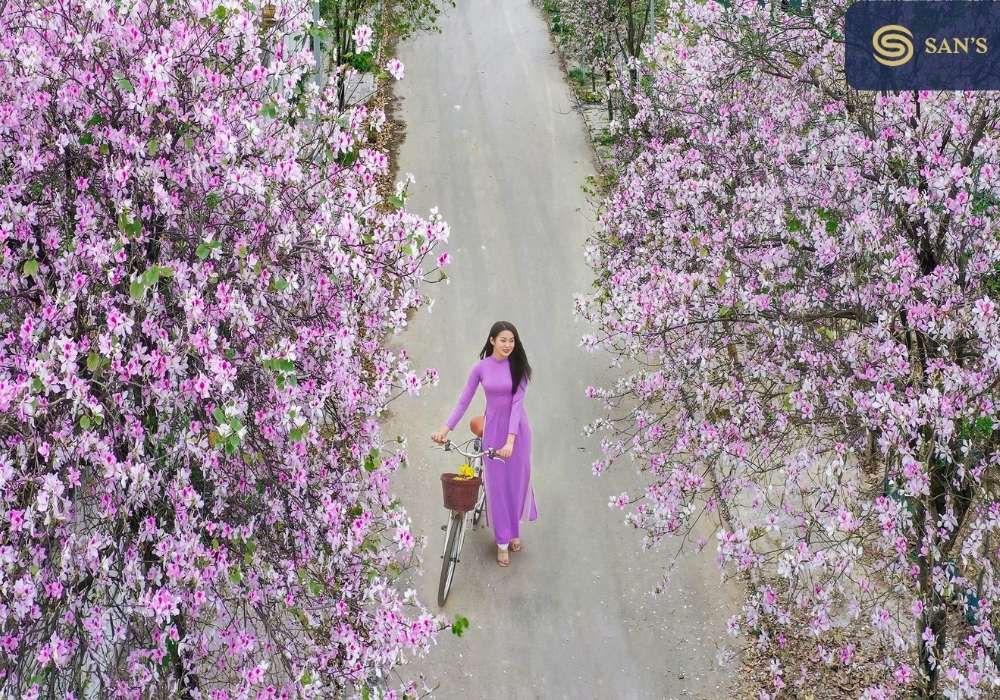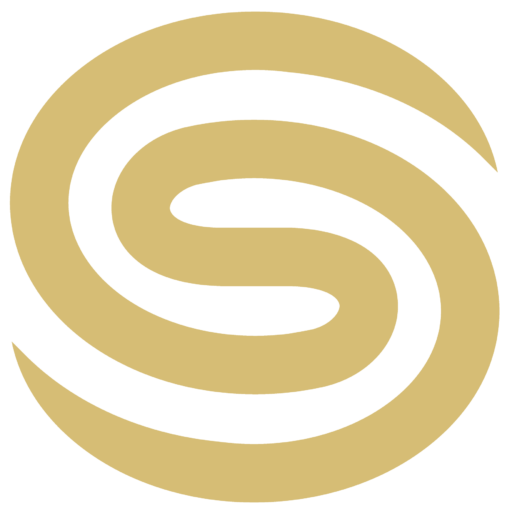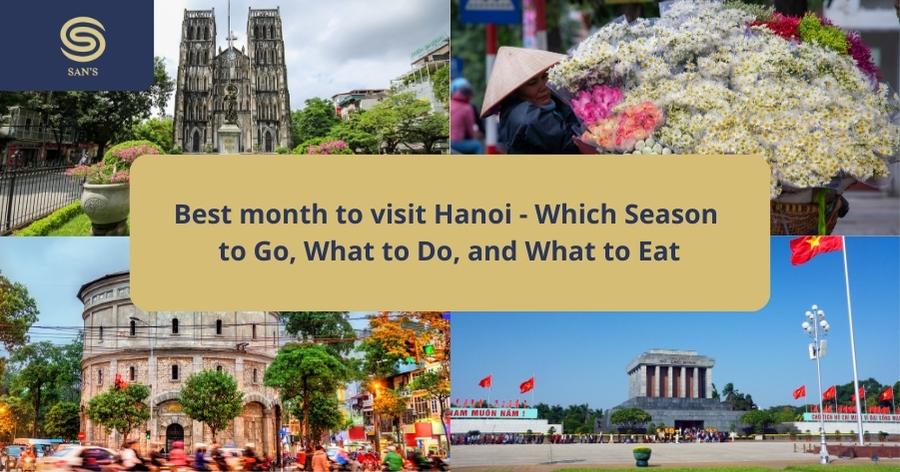Spring in Hanoi is not just about the changing weather or the blossoming flora. It’s an intricate tapestry of cultural celebrations, culinary delights, and the city’s centuries-old traditions coming to the forefront.
From the festive spirit of Tet Nguyen Dan, the Vietnamese Lunar New Year, to the sight of peach blossoms adorning homes as symbols of prosperity, spring in Hanoi offers a unique blend of nature’s beauty and cultural richness.
It’s a time when the past and the present seamlessly merge, creating an atmosphere that’s both nostalgic and hopeful. Whether it’s the scent of traditional foods wafting through the air or the sound of laughter and music from local celebrations, spring in Hanoi is an experience, a feeling, and most importantly, a celebration of life.

Spring in Hanoi typically spans from late February to April, characterized by a gentle transition from the colder winter months to the more humid prelude of summer. The early days of spring might still carry a residual winter chill, especially in the mornings and evenings.
However, as the weeks progress, the days become warmer, with average temperatures ranging from 15°C to 25°C. This period sees a significant decrease in the heavy fog that blankets the city during winter. Rainfall is moderate, with occasional drizzles that add freshness to the air, setting the stage for the flora to bloom in all its glory.
>>> Best time to visit Vietnam
How the weather affects daily life and activities
The milder temperatures and pleasant weather of spring breathe a different kind of life into Hanoi’s daily rhythm. Residents shed their winter layers, and the outdoor spaces become hubs of activity.
The lakeshores, such as those of the famed Hoan Kiem Lake, witness more joggers, couples, and families soaking in the serene environment. Street vendors showcase vibrant arrays of spring flowers, especially the iconic peach blossoms and kumquat trees, which are considered symbols of good fortune for the upcoming Lunar New Year.
Outdoor cafes and eateries become particularly popular, with locals and tourists alike enjoying their meals amidst the refreshing spring breeze. The favorable weather also sets the stage for various cultural festivities, with preparations often taking place outdoors. Traditional games, dances, and other activities become common sights in communal areas.
Moreover, the milder climate encourages exploration. Tourists find it especially conducive to roam the streets, delve into the city’s rich history, and engage in local customs and traditions. Whether it’s a leisurely cycle ride around the Old Quarter or a visit to the bustling markets, the spring weather in Hanoi ensures that every activity is imbued with a special charm.

Blooming Beauty: Hanoi’s Flora in Spring
Popular flowers and trees that blossom in spring
Spring in Hanoi heralds a spectacular display of nature as flowers and trees burst into bloom, each adding its own color and fragrance to the city’s landscape. Among the most iconic is the peach blossom, with its delicate pink petals symbolizing prosperity and growth.
These blossoms are particularly significant during the Tet festival, where they adorn homes and streets, acting as beacons of good fortune for the coming year.
The Ban flower, with its pristine white petals radiating from a golden core, is another springtime favorite, often associated with the pure and enduring spirit of the Vietnamese people. Then there’s the Sua flower, which turns the city into a dreamy realm with its snow-white blossoms, especially prominent in the ancient streets of Hanoi.
Apart from these, the vibrant colors of the Hoa Gao (cotton tree), with its fiery red blooms, and the Hoa Muoi Gio (Portulaca grandiflora), presenting a range of hues from pink to yellow, further enrich Hanoi’s spring canvas.

Best parks and gardens to experience spring’s bloom
For those keen to immerse themselves in Hanoi’s floral spectacle, several spots promise a fulfilling experience. The Botanical Gardens, located near Ba Dinh Square, offer a tranquil retreat with a diverse range of flora, showcasing both native and exotic species in full bloom during spring.
Hoan Kiem Lake, right in the heart of Hanoi, is surrounded by numerous trees and flowers that come alive in spring. The lakeside walking path provides a peaceful vantage point to admire the city’s blossoming beauty, with peach and apricot trees lending a rosy hue to the surroundings.
Thu Le Park, with its spacious layout and serene environment, becomes a haven for flower enthusiasts. The meticulously manicured gardens and vast green spaces are dotted with blooming flowers, providing an ideal backdrop for leisurely strolls or picnics.
For a more localized experience, the streets of the Old Quarter themselves transform into makeshift gardens, as vendors display an array of spring flowers in preparation for the Tet celebrations. Walking these ancient streets amidst the scent and sight of fresh blossoms is a unique experience, capturing the essence of spring in Hanoi.

Spring Festivals and Cultural Events
Tet Nguyen Dan: Vietnamese Lunar New Year
Arguably the most significant festival in the Vietnamese calendar, Tet Nguyen Dan, commonly referred to as Tet, marks the arrival of spring based on the lunar calendar. Celebrated over several days, it’s a time of family reunions, ancestral veneration, and an outpouring of cultural richness.
The streets of Hanoi are awash with color, as vibrant red and gold decorations, symbolizing luck and prosperity, adorn homes, businesses, and public places. Traditional foods like “Banh Chung” (square rice cake) and “Banh Day” (round rice cake) are prepared and shared among family members.
Lion dances, fireworks, and the giving of “li xi” (lucky money in red envelopes) to children are integral parts of the Tet celebrations. The atmosphere is one of joy, hope, and reflection, as Hanoians bid farewell to the old year and usher in the new with optimism.
Perfume Pagoda Festival
One of Vietnam’s most significant pilgrimage sites, the Perfume Pagoda, located about 60 kilometers southwest of Hanoi, hosts an annual festival that kicks off after the Lunar New Year and lasts until the end of the spring season. Devotees and tourists alike embark on a journey, first by boat through scenic waterways flanked by limestone mountains and then on foot or via cable car, to reach the sacred pagoda situated within a cave.
The festival is a blend of religious fervor, cultural performances, and traditional games. Devotees come to pray for a prosperous year, health, and happiness, while also immersing themselves in the serene beauty of the surroundings.
Other notable events and celebrations
- Hoa Sua Festival: As the “milk flower” or Hoa Sua blossoms in spring, certain areas of Hanoi, especially around the city’s universities, host events celebrating this fragrant flower. The air filled with its sweet scent, cultural performances, and night markets make it a memorable experience for both locals and visitors.
- Traditional Folk Games: During the spring season, especially around Tet, various neighborhoods in Hanoi organize traditional games like “Bau Cua Ca Cop” (a Vietnamese gambling game) and “Tug of War.” These games, often played in open spaces or streets, provide a glimpse into Vietnam’s rich cultural heritage and the community spirit of Hanoians.
- Spring Calligraphy Markets: Drawing from the ancient tradition of scholars writing wishes in calligraphy as a Tet ritual, several markets pop up in Hanoi during spring. The most famous is perhaps the one at the Temple of Literature, where calligraphers display their skills, and people buy these inscriptions as symbols of luck and intelligence for the coming year.
All these events, infused with the spirit of spring, further elevate Hanoi’s cultural tapestry, offering locals and tourists a deeper understanding of the city’s traditions and values.

FAQs about Spring in Hanoi
- When does spring in Hanoi officially start?
- Spring in Hanoi typically begins in late February and lasts until April.
- What can visitors expect from the weather during spring in Hanoi?
- During spring in Hanoi, average temperatures usually hover between 15°C to 25°C.
- Does spring in Hanoi experience rainfall?
- Spring in Hanoi does see moderate rainfall, with occasional light drizzles, but it’s not as frequent or heavy as the summer monsoons.
- What attire is suitable for spring in Hanoi?
- For spring in Hanoi, it’s best to have light layers, as daytime can be warm while mornings and evenings might still be cooler. An umbrella or light rain jacket is a good idea for unexpected showers.
- Which flowers signify spring in Hanoi‘s bloom?
- Spring in Hanoi is marked by the blossoming of peach flowers, Ban flowers, Sua flowers, Hoa Gao, and Hoa Muoi Gio, among others.
- Are there spring-specific festivals in Hanoi?
- Absolutely! Spring in Hanoi is culturally rich, with festivals like Tet Nguyen Dan and the Perfume Pagoda Festival, making it a vibrant time for visitors.
- Is spring in Hanoi recommended for tourism?
- Definitely! Spring in Hanoi offers one of the best times for tourists, thanks to its pleasant weather and the city’s festive spirit.
- How do spring in Hanoi‘s street markets differ from other seasons?
- During spring in Hanoi, street markets are vibrant with festive decorations, traditional foods, and an array of flowers in preparation for Tet celebrations.
- Where can I best experience the essence of spring in Hanoi, especially the peach blossoms?
- For a true essence of spring in Hanoi, locations like the Old Quarter, Hoan Kiem Lake, and various city parks are perfect to witness the beautiful peach blossoms.
- Are there any traditional foods linked with spring in Hanoi?
- Yes, spring in Hanoi, especially around Tet, is the time for traditional delicacies like “Banh Chung,” “Banh Day,” and various candied fruits.





